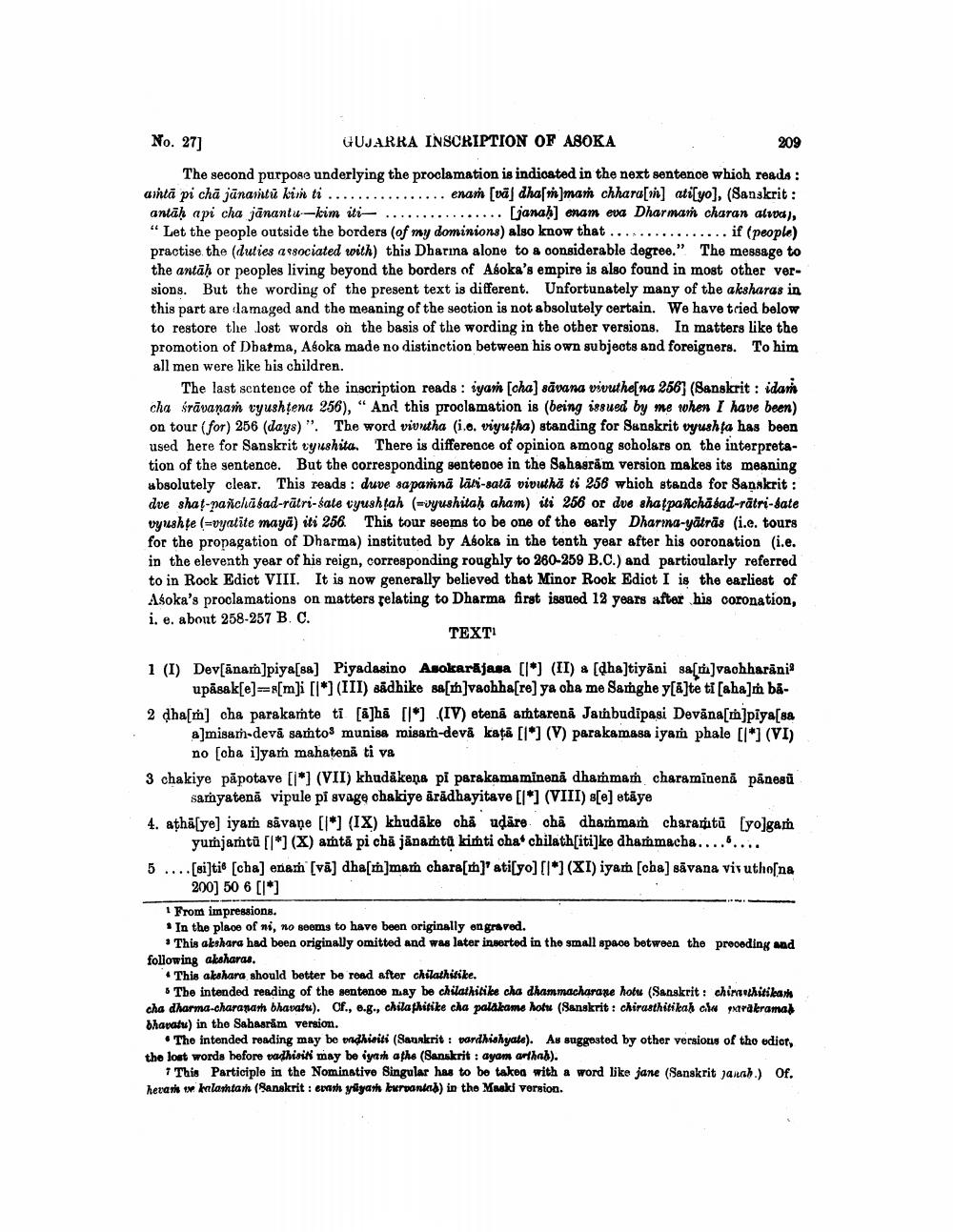________________
No. 27] GUJARRA INSCRIPTION OF ABOKA
209 The second purpose underlying the proclamation is indicated in the next sentence which reads: antā pi chā jūnaitu kin ti ................ enam [vāj dharm]man chhara[vn] ati(yo), (Sanskrit: antāk api cha jānantu-kim iti- ................ [janah] enam eva Dharmań charan alvod), “Let the people outside the borders (of my dominions) also know that ................ if (people) practise the (duties associated with) this Dharına alone to a considerable degree." The message to the antāh or peoples living beyond the borders of Asoka's empire is also found in most other versions. But the wording of the present text is different. Unfortunately many of the aksharas in this part are damaged and the meaning of the section is not absolutely certain. We have tried below to restore the lost words on the basis of the wording in the other versions. In matters like the promotion of Dbatma, Asoka made no distinction between his own subjects and foreigners. To him all men were like his children.
The last sentence of the inscription reads : iyan [cha) sāvana vivuthe[na 256] (Sanskrit : idam cha śrāvanam uyushtena 256), "And this proclamation is (being 188 ued by me when I have been) on tour (for) 256 (days)". The word vivutha (i.o. viyutha) standing for Sanskrit vyushta has been used here for Sanskrit ryushita. There is difference of opinion among scholars on the interpretation of the sentence. But the corresponding sentenoe in the Sahasram version makes its meaning absolutely clear. This reads: duve sa pannā lān-satā vivutha ti 256 which stands for Sanskrit: dve shat-panchabad-rātri-sate vyushtah (wyushitah aham) iti 256 or dve shatpanchädad-rätri-sate vyushțe (=vyatite mayā) iti 256. This tour seems to be one of the early Dharma-yātrās (i.e. tours for the propagation of Dharma) instituted by Asoka in the tenth year after his ooronation (i.e. in the eleventh year of his reign, corresponding roughly to 260-259 B.C.) and particularly referred to in Rock Edict VIII. It is now generally believed that Minor Rook Ediot I is the earliest of Asoka's proclamations on matters relating to Dharma first issued 12 years after his coronation, i. e. about 258-257 B. C.
TEXTI
1 (I) Dev[ānam]piya[sa] Piyadasino Asokarājasa [l*) (II) a (dha]tiyāni sa[m]vachharani?
upāsak[e]=r[m]i [[*] (III) sādhike sa[m]vaobha[re) ya cha me Samghe y[á]te ti [aha]m ba2 dha[m] cha parakaṁte ti [@]hā [*] (IV) etenā amtarenā Jaunbudipasi Devāna[m]piya[ 8a
a]misam-devā samtos munisa misam-devå katā [l*] (V) parakamasa iyam phale [[*] (VI)
no [cha ilyar mahatenă ti va 3 chakiye pāpotave [i*] (VII) khudākeņa pi perakamaminenā dhamma charaminenā pānesū
samyatenă vipule pi svage chakiye ārādhayitave [l*] (VIII) s[e] etāye 4. athafvel iya såvane [1] (IX) khudāke chå udare cha dhammam charantü fyolga
yumjamtā [[*] (X) amtā pi cbā jāpanta kiti cha chilath[iti]ke dhammacha......... 5 ...[si]tie [cha] enam (vā] dha[m]maṁ chara[m] atisyo] [l*] (XI) iyam (cha] sāvana viruthorna
200] 50 6 [*] 1 From impressions. . In the place of ni, no seems to have been originally on graved.
*This akshara had been originally omitted and was later inserted in the small space between the preceding and following aksharas.
This akshara should better be road after chilathitike.
The intended reading of the sentence may be chilathitike cha dhammacharane hotu (Sanskrit: chimasthitika cha dharma-charanam bhavatu). Of., 6.g., chila thitike cha palakame hotte (Sanskrit: chirasthitilah alu praleramal bhavatu) in the Sahasrām version.
• The intended reading may be mdhisiti (Saurkrit : vardhishyate). As suggested by other versions of tho udior, the lost words hefore vadhisit may be iyarh aths (Sanskrit : ayan arkhab).
* This Participle in the Nominative Singular has to be takog with a word like jane (Sanskrit janah.) Of. heran w Irlantan (Sanskrit : epsh yuyash kurvankb) in the Maski vorsion.




